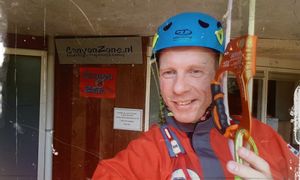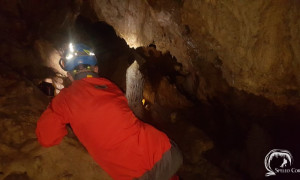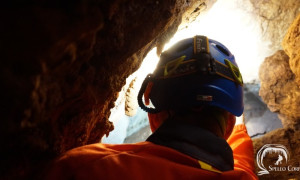Will the mystery of the ΄Tripa tou Pelaou΄ cave (Hole of the sea) ever be solved?
1557236612.jpg?crop=800,480)
caves
08 Μαΐου 2019
/ 06:31
CORFU. Speleologist and caver René van Vliet and Andreas Korikis explored the cave ΄Tripa tou Pelaou΄ in Agios Mattheos.
Many of us have heard about the 'Tripa tou Pelaou' cave in Agios Mattheos which is said to have seven levels and to be connected to the sea. There are many stories about the cave, one of which says that a cat was thrown into the cave and the next day was seen swimming in the sea. René van Vliet says, "Today we can take another look at that story. The constant temperature of a cave is 17-19 C. Hypothermia is the most serious threat to a speleologist and an animal. If the cat had fallen into the cave, it would have broken a lot of bones and an injured cat cannot walk great distances in a cold cave and swim in the sea the next day. The animal would have died inside the cave due to its injuries and hypothermia.
Another story says that a lamb or goat fell into the cave and after a few days the animal's carcass was found on Paramonas beach and it has been said since two or three generations ago that there is a large room on the sixth or seventh level."
1557236625.jpg)
Entrance to Tripa tou Pelaou cave in Agios Mattheos
The first description of the cave dates back to 1822. The writer Stylianos Vlassopoulos was a Corfu judge and lawyer and also wrote various scientific works including the book "Corfu Notes", which he began in 1809 and finished in 1811.
Stylianos Vlassopoulos wrote about the Tripa tou Pelaou cave, "At the bottom of the entrance hole there seems to be the start of a flat downhill path going into the mountain. If you drop a small or large stone here, you can hear it tumbling down but it quickly stops and for seven or eight seconds there is silence followed by a loud bang like the sound of thunder in the depths of the mountain, indicating that the stone has hit a rock."
The writer believed that the stone sounded as though it had hit water. He repeated his experiments with stones of different sizes with the same result.

Andreas Korikis entering the Tripa tou Pelaou cave
Using Galileo's formula, Vlassopoulos calculated that a stone falling for seven seconds must travel 735 feet or 147 Venetian metres. A Venetian metre is 1.75 meters and that means the depth of the cave was 270 metres! Vlassopoulos assumed that the mountain in Agios Mattheos was completely hollow inside and that it could collapse from one moment to the next.
The writer Ioannis Bounias also wrote about Tripa tou Pelaou in his 1954 book "Corfu History and Folklore Volume 1" and said that a falling stone could be heard for about seven seconds.
There is also an interesting story from a man who said that when he was young, 53 years ago, he entered the small opening which is located some metres below the entrance to the Tripa tou Pelaou cave, and ended up in the main room of the cave!
1557236638.jpg)
The small opening under the mountain is full of soil
Two French speleologists visited the cave in the past but the results of their exploration has not been recorded. The speleologist and caver René van Vliet visited the cave in 2018 and after more research into the history of the cave and with the right equipment, the cave could be explored in the spring of 2019.
The questions to which he sought answers were:
- What is the interior of the cave like and how many levels does it have?
- How is the cave decorated?
- What kind of animals live in the cave?
- Is there a connection between the Tripa tou Pelaou cave and the small opening that is located some metres below the entrance?
1557236643.jpg)
After the necessary preparations above ground the descent into the cave could begin
Recently, speleologist and caver René van Vliet and Andreas Korikis, along with Kostas Andriotis and Christos Kapodistrias, visited the summit of the mountain in the village of Agios Mattheos. 45 years ago Kostas Andriotis wrote an article about all the small hollows in the area and together with Christos Kapodistrias cleared 4 km of mountain trails!
"The entrance to the Tripa tou Pelaou cave is small and many beautiful green stalactites have formed inside the cave. The first level of the cave has a depth of 8 metres with a slope of 13 metres. During the descent we had to pass some sharp rocks and for that reason rope protectors were required."
1557236650.jpg)
The decoration on the ceiling of the cave
"Inside the cave many bats were spotted and on the floor of the first level there was a lot of bat guano. After the main room of the cave comes the second level with a narrow passage 9 metres deep. Then comes the third level with an equally narrow passage 3 metres deep. The floor here is blocked by soil.
In the past many people have thrown stones into the cave but on the first level no stones were visible. Possibly the stones will be found under the soil on the third level. A connection with the small opening located below the entrance to the Tripa tou Pelaou cave was not found on the first level.
During the next visit we will try to remove the soil from the third level of the cave to discover if there is fourth level."
1557236654.jpg)
Decorations on the ceiling of the main room of the cave
More information about the caves of Corfu can be found on the Speleo Corfu website.
René van Vliet would like to thank all those who assisted him. "I was able to visit the cave thanks to the kind help of Andreas Korikis, Christos Kapodistrias, Kostas Andriotis, CanyonZone, Rodcle and Aventure Verticale."
Another story says that a lamb or goat fell into the cave and after a few days the animal's carcass was found on Paramonas beach and it has been said since two or three generations ago that there is a large room on the sixth or seventh level."
1557236625.jpg)
Entrance to Tripa tou Pelaou cave in Agios Mattheos
The first description of the cave dates back to 1822. The writer Stylianos Vlassopoulos was a Corfu judge and lawyer and also wrote various scientific works including the book "Corfu Notes", which he began in 1809 and finished in 1811.
Stylianos Vlassopoulos wrote about the Tripa tou Pelaou cave, "At the bottom of the entrance hole there seems to be the start of a flat downhill path going into the mountain. If you drop a small or large stone here, you can hear it tumbling down but it quickly stops and for seven or eight seconds there is silence followed by a loud bang like the sound of thunder in the depths of the mountain, indicating that the stone has hit a rock."
The writer believed that the stone sounded as though it had hit water. He repeated his experiments with stones of different sizes with the same result.

Andreas Korikis entering the Tripa tou Pelaou cave
Using Galileo's formula, Vlassopoulos calculated that a stone falling for seven seconds must travel 735 feet or 147 Venetian metres. A Venetian metre is 1.75 meters and that means the depth of the cave was 270 metres! Vlassopoulos assumed that the mountain in Agios Mattheos was completely hollow inside and that it could collapse from one moment to the next.
The writer Ioannis Bounias also wrote about Tripa tou Pelaou in his 1954 book "Corfu History and Folklore Volume 1" and said that a falling stone could be heard for about seven seconds.
There is also an interesting story from a man who said that when he was young, 53 years ago, he entered the small opening which is located some metres below the entrance to the Tripa tou Pelaou cave, and ended up in the main room of the cave!
1557236638.jpg)
The small opening under the mountain is full of soil
Two French speleologists visited the cave in the past but the results of their exploration has not been recorded. The speleologist and caver René van Vliet visited the cave in 2018 and after more research into the history of the cave and with the right equipment, the cave could be explored in the spring of 2019.
The questions to which he sought answers were:
- What is the interior of the cave like and how many levels does it have?
- How is the cave decorated?
- What kind of animals live in the cave?
- Is there a connection between the Tripa tou Pelaou cave and the small opening that is located some metres below the entrance?
1557236643.jpg)
After the necessary preparations above ground the descent into the cave could begin
Recently, speleologist and caver René van Vliet and Andreas Korikis, along with Kostas Andriotis and Christos Kapodistrias, visited the summit of the mountain in the village of Agios Mattheos. 45 years ago Kostas Andriotis wrote an article about all the small hollows in the area and together with Christos Kapodistrias cleared 4 km of mountain trails!
"The entrance to the Tripa tou Pelaou cave is small and many beautiful green stalactites have formed inside the cave. The first level of the cave has a depth of 8 metres with a slope of 13 metres. During the descent we had to pass some sharp rocks and for that reason rope protectors were required."
1557236650.jpg)
The decoration on the ceiling of the cave
"Inside the cave many bats were spotted and on the floor of the first level there was a lot of bat guano. After the main room of the cave comes the second level with a narrow passage 9 metres deep. Then comes the third level with an equally narrow passage 3 metres deep. The floor here is blocked by soil.
In the past many people have thrown stones into the cave but on the first level no stones were visible. Possibly the stones will be found under the soil on the third level. A connection with the small opening located below the entrance to the Tripa tou Pelaou cave was not found on the first level.
During the next visit we will try to remove the soil from the third level of the cave to discover if there is fourth level."
1557236654.jpg)
Decorations on the ceiling of the main room of the cave
More information about the caves of Corfu can be found on the Speleo Corfu website.
René van Vliet would like to thank all those who assisted him. "I was able to visit the cave thanks to the kind help of Andreas Korikis, Christos Kapodistrias, Kostas Andriotis, CanyonZone, Rodcle and Aventure Verticale."







